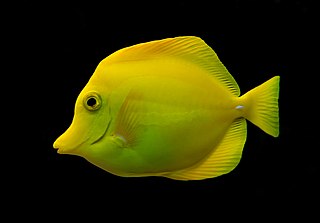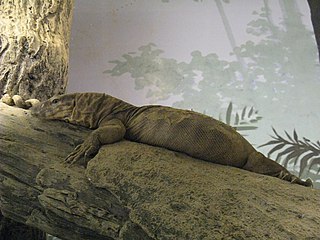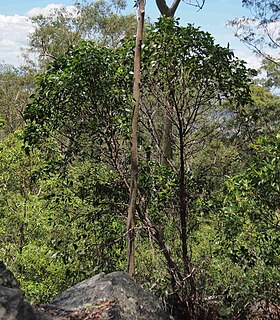
The yellow tang is a saltwater fish species of the family Acanthuridae. It is one of the most popular aquarium fish.

Chard or Swiss chard is a green leafy vegetable. In the cultivars of the Flavescens-Group, the leaf stalks are large and often prepared separately from the leaf blade; the Cicla-Group is the leafy spinach beet. The leaf blade can be green or reddish in color; the leaf stalks are usually white, or a colorful yellow or red.

The plains pocket mouse is a heteromyid rodent of North America. It ranges from southwestern Minnesota and southeastern North Dakota to northern Texas east of the Rockies, and from northern Utah and Colorado to northern Chihuahua west of the Rockies.

The yellow monitor or golden monitor, Varanus flavescens, is a species of monitor lizard found in Asia. It is also called Sun Gohoro. It is also known as SANGOIH (सनगोहि) in Maithili.

Pantala flavescens, the globe skimmer, globe wanderer or wandering glider, is a wide-ranging dragonfly of the family Libellulidae. This species and Pantala hymenaea, the "spot-winged glider", are the only members of the genus Pantala from the subfamily Pantalinae. It was first described by Johan Christian Fabricius in 1798. It is considered to be the most widespread dragonfly on the planet with good population on every continent except Antarctica although rare in Europe. Globe skimmers make an annual multigenerational journey of some 18,000 km ; to complete the migration, individual globe skimmers fly more than 6,000 km —one of the farthest known migrations of all insect species.

The Angolan slender mongoose is a mongoose that lives in southern Africa, specifically Angola and Namibia. It lives in the savannah and avoids desert and dense forests.
Oligoryzomys flavescens, also known as the flavescent colilargo or yellow pygmy rice rat is a species of rodent in the genus Oligoryzomys of family Cricetidae. It is found in southern South America, occurring in southern Brazil, Paraguay, Uruguay, and northeastern Argentina. Its karyotype has 2n = 64-66 and FNa = 66-70.
Mycobacterium flavescens is a species of the phylum Actinobacteria, belonging to the genus Mycobacterium.

The yellow mud turtle, also commonly known as the yellow-necked mud turtle, is a species of mud turtle in the family Kinosternidae. The species is endemic to the Central United States and Mexico.
The yellow serotine is a species of vesper bat.

The greater red musk shrew is a species of mammal in the family Soricidae. It is found in Lesotho, Mozambique, South Africa, and Swaziland. Its natural habitats are moist savanna, temperate grassland, and rural gardens.

The Jamaican fig-eating bat is a species of bat in the family Phyllostomidae. It is the only living species in the genus Ariteus. The scientific name translates as "yellowish and warlike". There are no recognised subspecies.

Sophora flavescens, the shrubby sophora, is a species of plant in the genus Sophora a genus of the Fabaceae family, that contains about 52 species, nineteen varieties, and seven forms that are widely distributed in Asia, Oceania, and the Pacific islands. About fifteen species in this genus have a long history of use in traditional Chinese medicines. The root is known as Ku shen and is a commonly-used in traditional Chinese medicine.

Cherry Lake is part of historical coastal wetlands in Altona, a suburb of Melbourne, Australia. The wetlands were converted to a lake with construction of retaining walls, levees, and flow channels. The lake and surrounding reserve is an important wildlife habitat and popular recreational destination.

Hesperilla flavescens, the yellow sedge-skipper or yellowish skipper, is a butterfly of the family Hesperiidae. It is found in the Australian states of South Australia and Victoria.

Matrine is an alkaloid found in plants from the genus Sophora. It has a variety of pharmacological effects, including anti-cancer effects, as well as κ-opioid and μ-opioid receptor agonism.

Trisetum flavescens, the yellow oatgrass or golden oat grass, is a species of grass in the Poaceae family. It is native to Europe, Asia, and North Africa.

Acacia flavescens, also known as the red wattle, yellow wattle or primrose ball wattle, is a tree in the Acacia genus native to eastern Australia.
Iris flavescens, also known as the lemonyellow iris, is a species of Iris that has distichous leaves and pale yellow flowers. It is similar in appearance to Iris sambucina, although with flowers that are more faded in colour. It can be found in Pennsylvania, United States.
Gibbestola griseovaria is a species of beetle in the family Cerambycidae. It was described by Stephan von Breuning in 1940. It is known from Brazil.
















